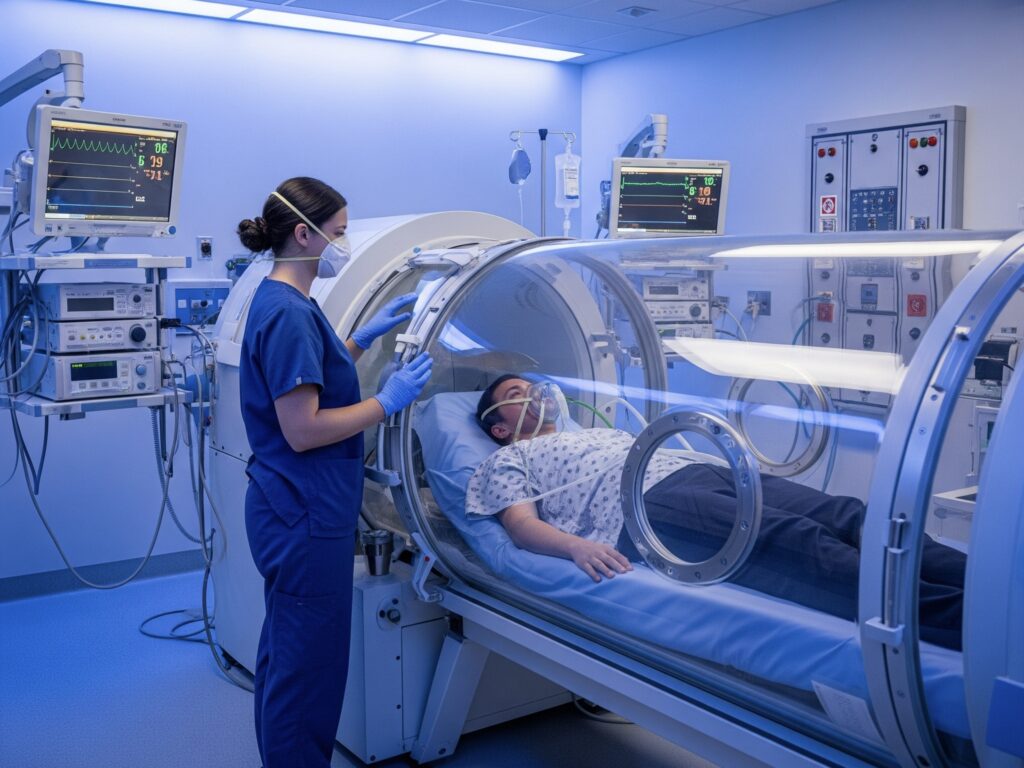Oxygen is essential for life. Every cell in your body depends on it to function, repair, and thrive. But what if your body could receive more oxygen than what’s available in the air we breathe every day? That’s the idea behind oxygen chamber therapy, also known as hyperbaric oxygen therapy (HBOT).
This innovative treatment has gained attention for its ability to promote healing, improve recovery, and even support wellness in ways traditional medicine sometimes cannot. Athletes, post-surgery patients, and individuals with chronic conditions have turned to oxygen chamber therapy for its potential benefits.
But before you book your first session, one question might be top of mind: Is oxygen chamber therapy safe? Let’s take a closer look at what this therapy is, how it works, its potential benefits, risks, and what you should know before stepping into an oxygen chamber.
What Is Oxygen Chamber Therapy?
Oxygen chamber therapy involves breathing pure oxygen inside a pressurized chamber. Normally, the air we breathe contains about 21% oxygen. Inside the chamber, however, oxygen levels increase dramatically, and the pressure is raised to two to three times normal atmospheric levels.
This combination allows your lungs to absorb much more oxygen than usual. The oxygen-rich blood then travels throughout your body, promoting healing, fighting infection, and supporting tissue repair.
Hyperbaric oxygen therapy (HBOT) has been used for decades in medical settings to treat conditions such as decompression sickness (common in divers), carbon monoxide poisoning, and non-healing wounds. Today, it’s also being explored for broader wellness and recovery purposes.
How Does It Work?
When you’re in an oxygen chamber:
- Increased pressure allows your lungs to take in more oxygen.
- Extra oxygen dissolves into your blood plasma, not just red blood cells.
- This oxygen-rich blood improves circulation, reduces swelling, and accelerates tissue repair.
The therapy typically lasts between 60–90 minutes per session, depending on your condition and treatment goals.
Potential Benefits of Oxygen Chamber Therapy
- Research and patient experiences suggest that HBOT may:
- Accelerate healing of wounds and injuries
- Reduce swelling and inflammation
- Support recovery after surgery
- Enhance performance and recovery in athletes
- Improve circulation and oxygen delivery to tissues
- Aid in neurological conditions such as traumatic brain injury or stroke recovery (ongoing studies)
Some people also seek oxygen chamber therapy for general wellness, claiming it helps with energy, focus, and overall vitality.
Is Oxygen Chamber Therapy Safe?
For most people, oxygen chamber therapy is considered safe when administered under professional supervision. Medical-grade chambers are designed with strict safety protocols, and certified providers monitor patients throughout each session.
However, like any treatment, there are some risks and considerations. Side effects are typically mild and temporary, but it’s important to know them before you start.
Possible Risks and Side Effects
- Ear or sinus pressure – Similar to what you feel on an airplane, caused by changes in air pressure.
- Temporary vision changes – Some people experience nearsightedness that usually resolves after treatment ends.
- Fatigue or lightheadedness – Common after a session but typically short-lived.
- Claustrophobia – Discomfort from being in an enclosed space.
Rare but more serious risks may include:
- Middle ear injuries (from pressure changes)
- Oxygen toxicity (if not properly regulated)
- Lung collapse (extremely rare, usually only in patients with pre-existing lung conditions)
This is why working with a qualified oxygen chamber therapy provider is essential—they’ll assess your health history and ensure the therapy is safe for you.
Who Should Avoid Oxygen Chamber Therapy?
Not everyone is a good candidate. Oxygen chamber therapy may not be safe if you have:
Untreated pneumothorax (collapsed lung)
- Severe COPD or other chronic lung conditions
- Uncontrolled high fever
- Certain ear or sinus problems
- Recent ear surgery
- Pregnancy (consult your doctor first)
Always disclose your full medical history to your provider before starting HBOT.
What to Expect at Your First Session
If you’re considering trying oxygen chamber therapy, here’s what typically happens:
- Consultation – A provider reviews your health history and treatment goals.
- Preparation – You’ll remove jewellery, watches, or electronic devices before entering the chamber.
- Inside the Chamber – You may sit or lie down while the chamber pressurizes. Some chambers allow you to watch TV or listen to music.
- Treatment – You’ll breathe pure oxygen for 60–90 minutes. You may feel ear pressure as the chamber pressurizes.
- After the Session – Most people return to normal activities immediately, though you may feel a little tired.
Tips Before Your First Session
- Wear comfortable, loose-fitting clothing.
- Avoid alcohol and smoking before treatment, as they can affect oxygen absorption.
- Stay hydrated.
- Communicate with your provider if you feel discomfort during pressurization.
Final Thoughts
So, is oxygen chamber therapy safe? The answer is yes when performed under professional supervision and with proper precautions. For many, it provides powerful benefits, from faster healing to improved energy and recovery.
That said, it’s not for everyone. Consulting with your healthcare provider and a certified HBOT specialist is the best way to determine if oxygen chamber therapy is right for you.
Your first session may feel new and unfamiliar, but with the right preparation and guidance, it can be a safe and potentially life-changing step toward better health and healing.

